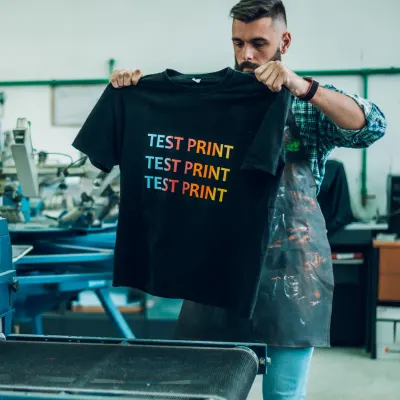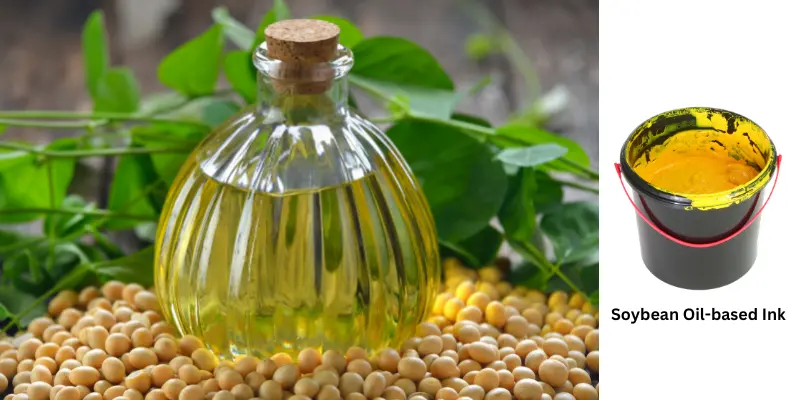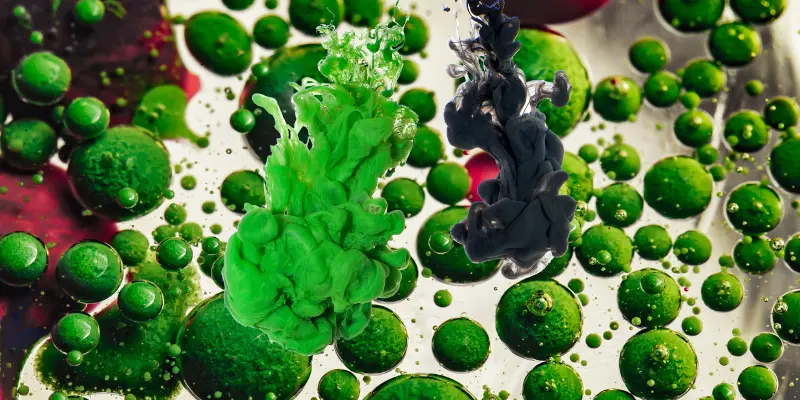In today’s eco-conscious world, the printing industry is taking shift toward sustainable ink, which is an environmentally friendly alternative to traditional petroleum-based inks.
Sustainable inks are made using renewable resources such as vegetable oils (soybean, linseed, canola), water-based solutions, and algae-based pigments, making them biodegradable, non-toxic, and very low in volatile organic compounds (VOCs).
Unlike conventional inks, which rely on Petro-chemicals that contribute to air pollution and hamper paper recycling, sustainable inks reduce carbon footprint, improve recyclability, and support a waste free environment.
Sustainable inks are widely used to print packaging, publishing, and textile materials by companies that prioritize sustainability.
With growing awareness and demand for eco-friendly printing method, sustainable ink is emerging as the future of green printing.
Introduction
What is Sustainable Ink?
Sustainable ink is an eco-friendly alternative to traditional petroleum-based inks. It is made from renewable, biodegradable, and non-toxic ingredients, making it safer for the environment and human health.
Main Ingredients of Any Printing Ink
Printing ink is made up of five key components that work together to give it color, consistency, and durability.
1. Pigments (Color Providers)
Pigments are the color particles found in the ink. They make the ink visible and opaque. Different pigments are used to create different colors.
For examples,
Black Ink → Often made from carbon black.
White Ink → Made from titanium dioxide.
Other Colors → Can be made from natural or synthetic pigments.
2. Binders (Holds Everything Together)
Binders are also called resins, which helps the ink to stick on the substrate for a longer time after printing.
Common binders include:
Natural resins (like rosin)
Synthetic resins (like acrylic or polyurethane)
Without a binder, the ink would rub off easily after printing. So, it is necessary to add binder in the ink for durable print.
3. Carriers (Ink Flow & Drying)
Carriers make the ink in liquid form. Once the ink is applied, the carrier evaporates, and the ink remains on substrate.
Types of carriers: Water-based, Vegetable oil-based, and Solvent-based.
4. Additives (Enhancing Ink Performance)
Additives are also added to increase the functionality of ink, such as gloss level, viscosity, resistance to heat, UV light, and smudging.
5. Drying Agents (For Faster Drying Time)
Drying agents are used to dry ink faster after printing.
Ink Composition (Approximate Breakdown by Weight)
| Component | Percentage in Ink | Purpose |
| Pigments | 5–30% | Adds color and opacity |
| Binders | 15–40% | Helps ink to stick on the surfaces |
| Carriers | 30–70% | Makes ink transferable |
| Additives | 1–5% | Enhances the functionality of ink |
| Drying Agents | 1–5% | Helps ink to dry faster |
Carefully designed mixture of pigments, binders, carriers, and additives are very crucial to get high-quality and long-lasting prints.
Impacts of Petroleum-based Ink
Imagine having a beautifully printed magazine, a coffee cup with a colorful logo, or a food package with eye-catching graphics. Have you ever thought about the toxic ink used in these prints?
Most traditional inks are made from petroleum-based chemicals and heavy metals, which can be harmful to people and planet.
Air Pollution
Traditional inks release volatile organic compounds (VOCs) during printing and drying, contributing to air pollution and smog formation.
These VOCs emission can also cause respiratory diseases and other health-related problems in workers. These workers have their own families to feed and support. We will discuss this in detail.
Water Contamination
When excess ink or printed materials are thrown away, the ink can pollute rivers and oceans. These pollutants can harm aquatic life and also to the humans once they reach to ground water.
Traditional water purification methods can’t filter out these toxic chemicals, which can build up in our bodies over time.

They can also enter into the food chain when we eat meat or vegetables grown with this polluted water.
Difficult to Recycle
Paper printed with petroleum-based ink is harder to recycle because the ink adheres strongly to fibers. Removing this ink requires extra energy along with harsh chemicals, which again creates pollution.
High Carbon Footprint
Since traditional inks are derived from non-renewable fossil fuels, their production and use contribute to greenhouse gas emissions followed by climate change.
This is why sustainable ink, like vegetable-based, water-based, or algae-based inks, are gaining popularity day by day. They significantly reduce pollution and make printing more eco-friendly!
What Are the Health Issues Associated with Printing Workers?

1. Respiratory Diseases
Inhalation of VOCs leads to chronic respiratory issues, including:
Asthma – VOCs trigger airway inflammation, leading to breathing difficulties.
Chronic Bronchitis – Prolong exposure, damages the bronchial tubes, causing persistent cough and mucus buildup.
Lung Irritation & COPD (Chronic Obstructive Pulmonary Disease) – Chemicals like benzene, toluene, and formaldehyde cause lung damage and increasing risk of COPD.
Symptoms: Shortness of breath, coughing, wheezing, and chest tightness.
2. Neurological Disorders
Many VOCs and heavy metals used in petroleum-based inks are neurotoxic, which means they can damage the nervous system over time.
Headaches & Dizziness – Common with toluene and xylene exposure.
Memory Loss & Concentration Problems – VOCs affect brain function, leading to confusion and reduced focus.
Peripheral Neuropathy – Workers may feel numbness, tingling, or weakness in hands and feet due to nervous system damage.
3. Cancer Risk
Certain VOCs in ink are classified as carcinogens (cancer-causing substances).
Benzene Exposure – Linked to leukemia (blood cancer).
Formaldehyde – Associated with nasal and throat cancer.
Styrene & Toluene – Can increase risk of lung and liver cancer.
Fact: Printing press workers with long-term exposure to VOCs have a higher risk of leukemia and lymphoma.
4. Skin Diseases & Allergies
Printing workers often experience skin irritation due to direct contact with ink solvents. It is better to use PPE kit during handling of chemicals.
Dermatitis (Skin Inflammation) – Causes itching, rashes, and redness.
Chemical Burns & Ulcers – Harsh solvents in ink can damage skin tissue.
5. Liver & Kidney Damage
VOCs can be absorbed through our skin and enter the bloodstream, which are subsequently being processed by the liver and kidneys. Over time, this can result in:
Liver Toxicity – Chemicals like toluene, benzene, and xylene damage liver cells, which are increasing the risk of liver disease.
Kidney Dysfunction – Chronic exposure can lead to kidney failure.
Fact: Printing workers exposed to high VOC levels for many years are at risk of liver cirrhosis and kidney failure.
How Petroleum-Based Ink Migrates and Affects Consumers?
Petroleum-based inks can migrate from printed packaging materials into food, pharmaceuticals, and other consumer products.
This migration poses a serious health risk, especially when packaging materials come in direct or indirect contact with consumable items.
Example 1,
Imagine a cough syrup stored in a plastic bottle, where the printed sticker label uses petroleum-based ink.
How the Ink Migrates:
Over time, solvent residues in the ink slowly evaporate and pass through the plastic wall of the bottle.
These toxic ink chemicals dissolve into the cough syrup.
The consumer unknowingly ingests these harmful substances when taking the medicine.

Example 2,
Imagine a T-shirt with a printed design that uses petroleum-based ink. These inks contain harmful chemicals like phthalates, benzene, toluene, and heavy metals, which may leach into our skin upon wearing.
How the Ink Migrates:
When we wear printed clothing, our body heat and sweating soften the ink, causing toxic chemicals to release from the fabric.
These ink chemicals transfer onto the skin and get absorbed through sweat glands and pores.
Over time, the toxic ink chemicals enter the bloodstream, accumulating in organs like the liver, kidneys, and lungs.

Fact: Studies have shown that certain textile dyes and petroleum-based inks contain carcinogenic compounds, which can be absorbed through prolonged skin contact.
Refer my blog post: Most Sustainable Clothing Fabrics for choosing right fabrics.
Comparison: Sustainable Ink vs. Traditional Ink
Your choice of ink plays a crucial role in Saving environmental.
| Feature | Sustainable Ink | Petroleum-Based |
| Main Ingredients | Vegetable oils (soy, linseed, canola), water, or algae-based pigments | Petroleum-derived chemicals, heavy metals, and synthetic solvents |
| Environmental Impact | Low (eco-friendly, biodegradable) | High (pollution, non-biodegradable) |
| VOC Emissions | Low or none | High |
| Recyclability | Easier to remove from paper during recycling. | Difficult to deink during recycling. |
| Biodegradability | Biodegradable | Non-biodegradable |
| Carbon Footprint | Low | High |
| Toxicity | Non-toxic, safer for workers and consumers | Contains toxic chemicals and heavy metals |
| Drying Time | Slightly longer | Faster drying time due to the nature of solvents |
| Durability | High (especially UV-curable inks) | High, but often contains harmful additives |
| Usage | Newspapers, eco-packaging, sustainable branding, textiles, and corporate printing | Mass-market printing, traditional packaging, and industrial printing |
| Cost | Slightly high | Generally cheaper, but has hidden environmental costs |
Although sustainable ink may cost slightly higher initially, its long-term benefits far outweigh the environmental and health risks associated with petroleum-based inks, including health issues in people and the disaster management costs associated with climate change.
Benefits of Sustainable Ink
By switching to eco-friendly inks and printing methods, the industry can significantly reduce its impact on the people and planet. Here’s how:

Reduce Pollution
Sustainable inks, like soy-based or water-based inks, produce fewer VOCs, making the air cleaner and the printing process safer for workers.
Reduce Explosion during Ink Manufacturing
By eliminating the use of petrochemicals, the manufacturing process for sustainable inks becomes inherently safer.
The absence of highly flammable materials reduces the likelihood of accidental ignition and explosion, creating a safer working environment for employees and minimizing the risk of industrial accidents.
Easier Recycling & Less Waste (De-inking Process)
When printed materials use sustainable inks, it is easy to remove the ink during the recycling process. This means more paper can be reused with less energy and chemicals.
Lower Carbon Emissions
Many sustainable inks come from renewable sources like vegetable oils or algae, which are reducing dependency on fossil fuels and lowering the overall carbon footprint.
Algae-based inks are particularly beneficial because they are carbon negative, meaning they absorb carbon dioxide through photosynthesis as they grow. This makes them best eco-friendly choice for printing.
Supports Green Practices
Companies that prioritize sustainability in printing not only help the environment but also build a stronger brand reputation. Consumers today prefer eco-conscious brands that take responsibility for their environmental impact.
Real-World Example: Newspaper Printing
Did you know that most major newspapers today use soy-based ink instead of petroleum-based ink?
Why?
Soy ink is known for producing sharper and brighter colors, which enhances the quality of printed materials like newspapers.
Additionally, soy ink makes the recycling process easier because it can be easily removed from paper fibers during deinking.
This small change has significantly reduced paper waste, saving millions of tons of paper from ending up in landfills. Newspapers, which are frequently recycled, benefit greatly from this improvement.
Challenges & Limitations of Sustainable Ink
While sustainable inks offer numerous environmental benefits, they also come with a few challenges.
1. Drying Time (Longer than Petroleum-Based Inks)
One of the most common challenges with sustainable inks, especially vegetable-based and water-based inks, is that they tend to have a longer drying time compared to petroleum-based inks.
This can lead to delays in the printing process or slow run time, especially in high-speed industrial printing environments.
2. Higher Production Costs (But Reducing with Innovation)
Sustainable inks, particularly those made from vegetable oils or algae, can be more expensive to produce compared to traditional inks made from petroleum.
The raw materials for sustainable inks often cost more, and the production process can be more intricate.
3. Limited Availability
Not all types of sustainable inks are widely available. Algae-based inks, for example, are still a relatively new technology, and their availability is limited compared to more common options like soy-based inks.
Similarly, water-based inks are not yet as versatile or compatible with all printing surfaces or methods.
The Future of Sustainable Ink
The future of sustainable ink looks bright and promising as consumers, industries and innovators continue to push for eco-friendly alternatives to petroleum-based printing inks.
With advancements in technology, regulations, and consumer demand for greener products, the shift toward sustainable printing is gaining momentum.
1. Innovations in Biodegradable and Algae-Based Inks
Biodegradable Inks
As the demand for biodegradable products continues to grow, the focus is on inks that break down naturally and don’t leave harmful residues in the environment.
Research into biodegradable inks made from materials like corn starch, cellulose, and plant-based oils is progressing rapidly.
These inks are designed to offer the same quality, durability, and color vibrancy as traditional inks while being much less harmful to the planet and people.
- Biodegradable inks can degrade naturally when exposed to air, water, or soil, leaving no toxic waste behind.
- These inks are particularly useful for packaging materials, promotional items, and paper products that might end up in landfills.
- Using non-toxic inks on porous materials like plastic and paper, where ink migration is possible, is much safer compared to petroleum-based inks. This helps to reduce health risks in consumers.
Algae-Based Inks
One of the most exciting innovations in sustainable ink is the development of algae-based inks. Algae is a fast-growing, renewable resource, making it an ideal candidate for eco-friendly ink production.
- Algae-based inks are highly sustainable and can be produced with a low environmental footprint.
- Algae pigments are rich in color and offer vibrant, long-lasting prints.
- This technology is still emerging, but it shows great promise for reducing the carbon footprint and providing a sustainable alternative to traditional inks.
- Algae naturally contains ingredients like antioxidants, making these inks safer for use in packaging for pharmaceuticals, food, and cosmetics, unlike petroleum-based inks.
How to Prepare Algae-Based Ink?
It uses pigments extracted from algae, making it a renewable, biodegradable, and low-carbon ink option. Researchers and innovators are developing ecofriendly methods to scale up.
If you’re interested in making algae-based ink, here is a step-by-step guide:

1. Collecting & Cultivating Algae
The first step is to obtain algae, which can be found in natural water sources like lakes, ponds, and oceans. However, for controlled production, algae can be grown in a lab or a bioreactor.
How to Cultivate Algae:
1. Choose a Suitable Algae Strain – Some algae strains produce rich pigments (e.g., spirulina for blue-green, red algae for red, and chlorella for green).
2. Provide Sunlight or Artificial Light – Algae need light for photosynthesis to grow efficiently.
3. Use a Nutrient Medium – Algae grow well in water with nitrogen, phosphorus, and other nutrients.
Fast-growing algae like Chlorella and Spirulina are commonly used for ink production because they grow rapidly and produce strong pigments.
2. Extracting Pigments from Algae
Once the algae have grown, the next step is to extract their natural pigments. This process involves drying, crushing, and filtering the algae to get the color-rich particles.
Example: Spirulina produces a rich blue-green pigment (phycocyanin), which can be used for ink production.
3. Preparing the Ink Base
To turn algae particles into liquid form ink, you need to use carriers like vegetable-based oil or water based that helps the pigment to transfer on the surfaces.
For DIY ink, a simple water-based base works well.
4. Mixing the Pigments with Binding Agents
Once the algae pigment is mixed with carrier, it needs to be mixed with other components to turn it into usable ink.
Ingredients to Mix: Algae pigment, binder, carrier, and additives.
Steps to Mix the Ink:
1. Heat the Carrier Liquid.
2. Slowly Add Algae Pigment and stir it continuously to get an even color distribution.
3. Add the Binder, like gum arabic (for water-based ink) or natural resin (for oil-based ink).
4. Blend Until it forms smooth paste.
5. Filter through a fine mesh or cloth to remove lumps.
5. Testing & Adjusting the Ink
Before using the ink for printing, test it on different surfaces (paper, fabric, cardboard) to check its color strength, drying time, and consistency.
If the ink is too thick – Add more water or oil.
If the ink is too light – Add more algae pigment.
If the ink dries too slowly – Add a small amount of natural drying agent (e.g., cornstarch or alcohol).
6. Storing the Algae-Based Ink
Store in an airtight glass jar. Keep in a cool, dark place.
Add a natural preservative (like rosemary extract) to prevent spoilage.
How to Choose Sustainable Ink for Your Business
Selecting the right sustainable ink for your business is a crucial step in reducing your environmental impact while ensuring your print materials meet the necessary quality, brand reputation, and cost standards.
Below are key factors to consider when choosing eco-friendly inks and how to find printers that align with your sustainability goals.
1. Factors to Consider When Choosing Sustainable Ink
A. Ink Type
Different types of sustainable inks are available in the market, so it is essential to choose the best for your business. Here’s a breakdown of some common types:
Vegetable-Based Inks (e.g., Soy, Linseed)
Water-Based Inks
UV-Curable Inks
Algae-Based Inks (Emerging)
B. Print Quality
While choosing a sustainable ink, it is essential to ensure that the ink meets your quality standards. Here’s what to look for:
- Color Vibrancy – Ensure that the ink produces bright and vibrant colors for your brand marketing. Some sustainable inks, like soy-based ink gives rich and premium print while others not.
- Durability – If you are printing on materials that need to withstand wear and tear (like packaging or labels), consider UV-curable or oil-based inks, as they provide a higher level of durability compared to water-based inks.
- Color Consistency throughout Supply – Make sure the ink provides consistent color quality across supplies, particularly for branding and marketing materials where uniformity of color is a key.
C. Drying Time
Drying time is an important factor, especially in high-volume print orders.
Some sustainable inks, such as water-based inks, can have a longer drying time compared to petroleum-based inks, which may affect production speed and cost.
- Fast-drying inks, such as UV-curable inks, are perfect for high-volume production because they allow for quick turnaround times. However, it’s important to ensure safety from UV radiation exposure during production. Proper safety measures should be in place to protect workers from potential harm.
- If drying time isn’t an issue for your product, vegetable-based inks (such as soy or linseed) are great for general printing and packaging.
D. Cost
While sustainable inks tend to be more expensive upfront than traditional inks, prices are steadily decreasing as demand grows and technology improves.
However, the cost is still an important factor, especially for small businesses or startups.
- Vegetable-based inks tend to be a cost-effective option when compared to more specialized inks like algae-based inks.
- Water-based inks can be slightly more expensive than petroleum-based inks but often offer long-term savings in terms of health and environmental benefits.
2. How to Find Eco-Friendly Printing Services
If your business doesn’t have the capacity for in-house printing, choosing an eco-friendly printing service that uses sustainable inks is a great way to maintain your green initiative.
A. Research & Certification
Look for printers that hold eco-certifications or align with sustainability standards. Some important certifications include:
- FSC Certification (Forest Stewardship Council): Ensures the paper used is sourced from responsibly managed forests.
- Cradle to Cradle: Focuses on the entire lifecycle of products to ensure sustainability.
- Green Seal Certification: Verifies that the printing process meets specific environmental criteria, including the use of low-VOC inks.
- ISO 14001 Certification: Ensures that a company has an effective environmental management system in place.
B. Ask About Ink Types
When you contact printers, ask them directly about the types of inks they use, such as vegetable-based, Water-based inks, and UV-curable inks.
C. Review Their Sustainability Practices
In addition to sustainable inks, make sure the printers follow other eco-friendly practices.
- Use of recycled paper or sustainably sourced paper.
- Energy-efficient printing technologies.
- Waste reduction through recycling or composting.
- Eco-friendly packaging for deliveries.
- Proper disposal of excess inks and materials.
D. Check for Customer Reviews and Case Studies
As a packaging scientist, I often visit printing units. During these visits or audits, I noticed that some vendors are not transparent about their processes, while others are more open.
Some printing companies proudly highlight their green initiatives and share how they have helped other companies to reduce their carbon footprint.
This transparency not only builds trust but also showcases their commitment to sustainability.
Conclusion
The printing industry plays a huge role in sustainability, and by making better choices, we can protect natural resources, reduce pollution, and move towards a greener future.
Whether you are a business printing promotional materials or a consumer choosing eco-friendly packaging, every decision counts toward a sustainable planet!
Make the change, make a difference.
If you know about any exciting sustainable ink innovations or eco-friendly printing techniques, feel free to share them in the comments! I’d love to research and include them in future updates to spread more awareness about waste-free and sustainable printing.
